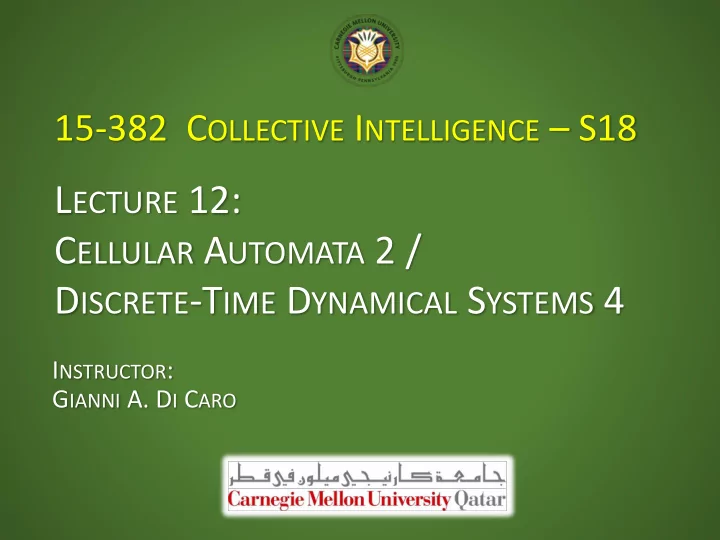

15-382 C OLLECTIVE I NTELLIGENCE – S18 L ECTURE 12: C ELLULAR A UTOMATA 2 / D ISCRETE -T IME D YNAMICAL S YSTEMS 4 I NSTRUCTOR : G IANNI A. D I C ARO
A ZOO OF BEHAVIORS : A NY REGULARITY ? 2
C LASS 1 3
C LASS 2 ≪ Rule 2 The direction and location of the lines depend on the initial conditions, but the structural fact that we will have lines in a certain direction is independent from initial conditions Sierpinski gasket 4
C LASS 3 Rule 184 5
C LASS 4 Universal computation! 6
R ULE 110 7
R ULE 110: S PACE -T IME SCALES 8
D EPENDENCE ON THE INITIAL STATE Dependence ~ Elaboration of initial conditions Structure does not depend but lines do No dependence Identification of parameter of structure Trivial elaboration Strong dependence Complex elaboration, Chaotic behaviors Hard to predict 9
D EPENDENCE ON INITIAL STATE 10
L YAPOUNOV EXPONENTS Two Lyapounov exponents: measuring information propagation on initial conditions along the two directions Both 0 exponents, information doesn’t travel Positive exponents, initial information travels far away Positive exponents, going to zero 11
U NIVERSAL COMPUTATION 12
U NIVERSAL COMPUTATION 13
L OCAL COMMUNICATIONS VS . GLOBAL BEHAVIORS 14
I NVERSE PROBLEM 15
R ULE 184: P ARITY PROBLEMS Why could 184 be a good candidate for parity detection problems? No single CA can solve the parity problem, but applying a sequence of elementary CAs can do it, for instance the following operator applied to a lattice of length 𝑀 : K. M. Lee, Hao Xu, and H. F. Chau , Parity problem with a cellular automaton solution , Phys. Rev. E 64 , 026702, 2001 16
Recommend
More recommend